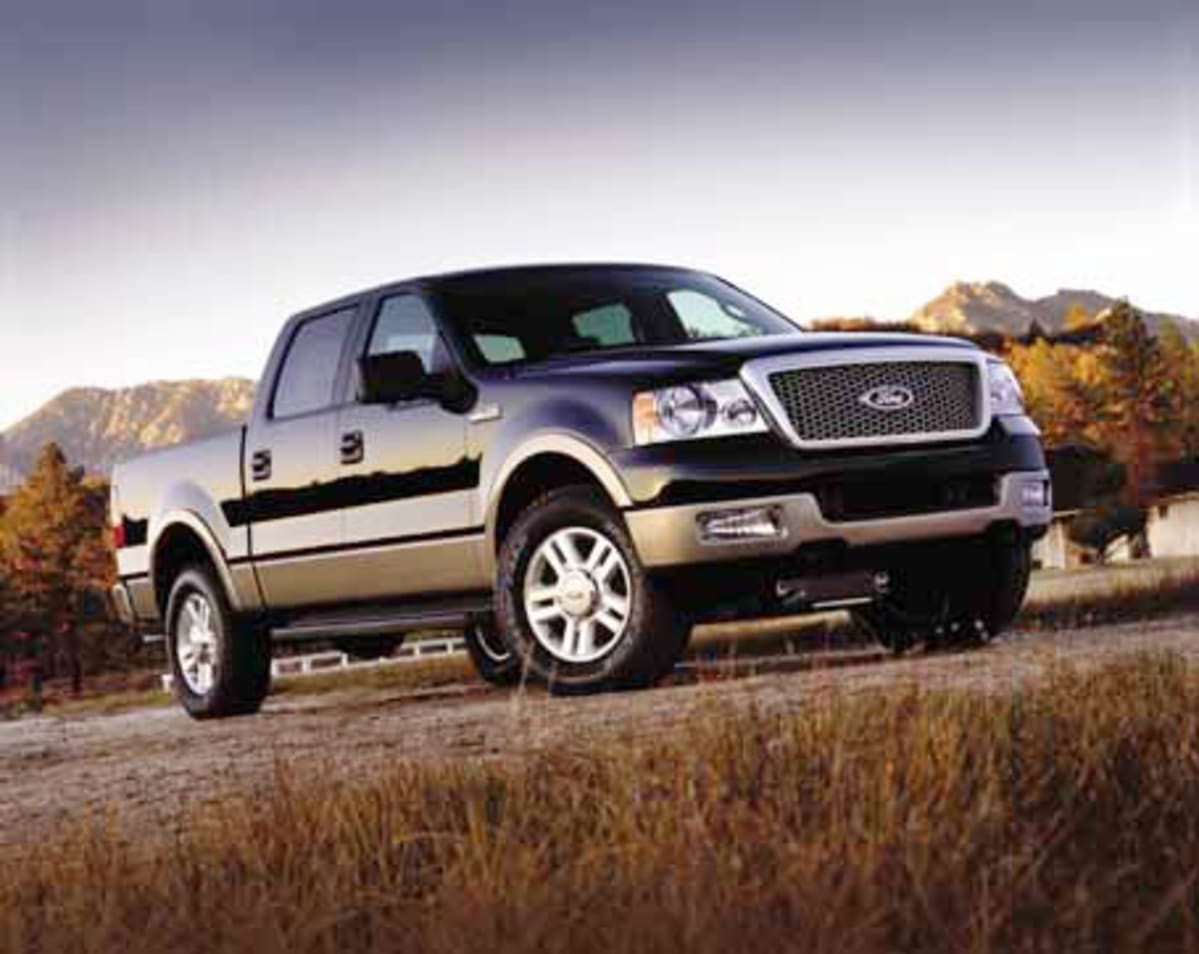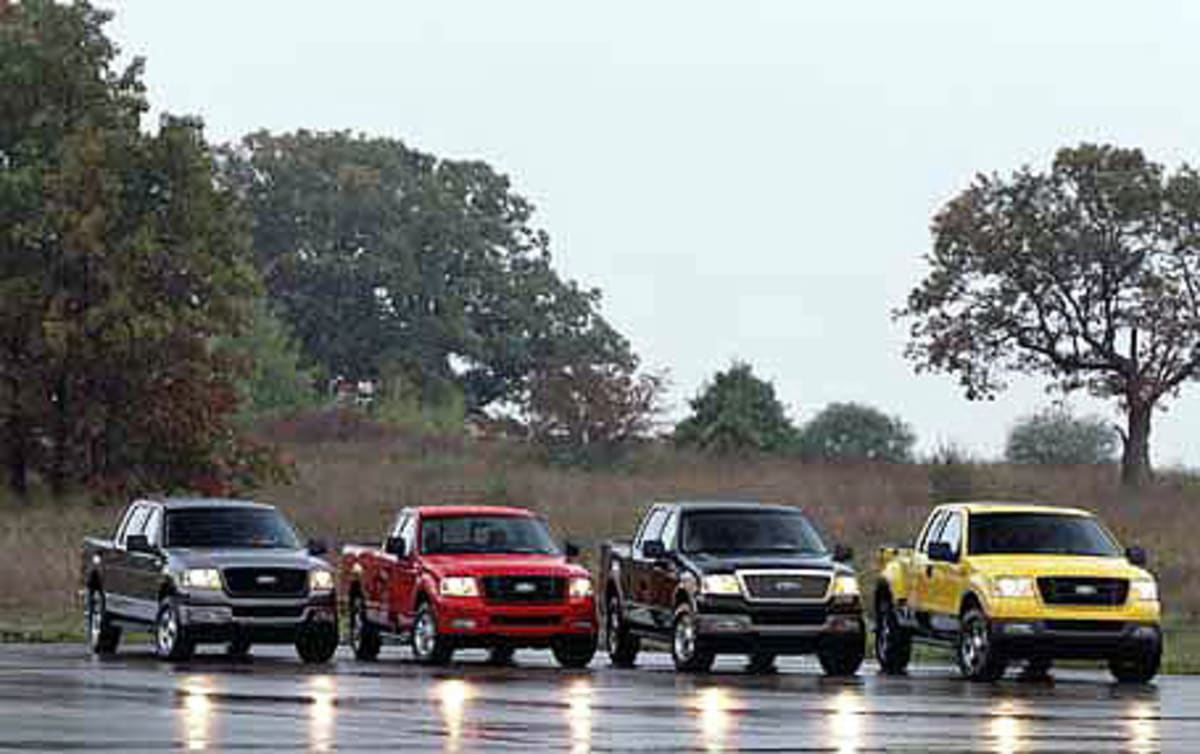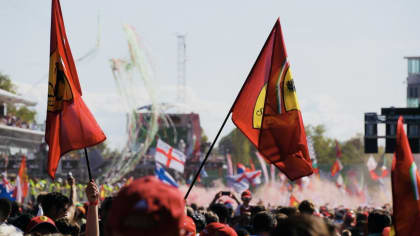THE BENCHMARK
This article is from our archives and has not been updated and integrated with our "new" site yet... Even so, it's still awesome - so keep reading!
Published on Mon, Aug 25, 2003
By: The LACar Editorial Staff
THE BENCHMARK
By ZORAN SEGINA
The laws of physics mandate that when you place a two-foot strip of plastic
on top of the steel cargo box gate there has to be room for temperature expansion.
Put simply, an F-150 owner from Phoenix will drive around Arizona in August
with longer plastic strip than his second cousin driving the same F-150 around
Christmas in Minneapolis.
When the new F-150 was in early design stage, the engineers left a quarter of
an inch on each side for the expansion. If they attempted to flush the strip
close to the side, the plastic would twist in hot weather. Underneath the strip
one could see the metal of the cargo door, which is ugly, but one cannot fight
physics, and a quarter inch expansion was customary accepted clearance in all
similar designs. After all, at Ford they always did it this way.
The problem with this approach is that the phrase “we always did it this
way” raises Steve’s eyebrows. Maybe it is his Welsh upbringing, or
the years he spent in aerospace industry, who knows, Steve just refuses to accept
conventional wisdom. Since Steve’s title at Ford Motor Company is a Chief
Body Engineer - Tough Truck, the upward movement of his eyebrows receives a
lot of attention. So, into the oven the plastic strip went, and when it came
out, a quarter of an inch was no longer customary accepted expansion tolerance
in the new F-150 design.
Tinkering with a competition go-kart, as Steve did in his teenage years, is
interesting. Tweaking a better performance from the vintage Cobra in his garage
is challenging. Playing with a design of a vehicle that sold over nine hundred
eleven thousand units in 2001 alone, and accounts for nearly twenty-eight percent
of Ford Division’s sales - now that’s serious intestinal fortitude
stuff.
Among cars and trucks there are certain models against which all others are
measured. If you endeavor to build a sport sedan, the result of your efforts
will inevitably be compared to BMW 3 series. You may claim that your product
is better, faster, stronger or cheaper, and all of it may be true, but the very
fact that another sedan - a BMW - is used as a benchmark, places that automobile
in a special position. It is the place attained by a select few after years
of hard efforts.
The results of this approach with the F-150 are impressive. The entire frame
is fully enclosed to form a closed “box” section rather than the traditional
“C” rail design, and uses hydroforming for the sections of the frame
rails that bear the loads of the front suspension. As a result the frame is
approximately nine times stiffer in torsion and approximately fifty percent
stiffer in bending compared to the current truck. Another innovation is the
placement of the rear shock absorbers outboard of the frame rails. Rear leaf
springs are three inches wider which is twenty percent bigger than in the 2002
F-150 to help reduce sway during cornering and considerably improve towing stability.
The shock position also provides better control of axle “skipping”
and “skating” that can happen on washboard-type surfaces. It is an
innovative application of the old racing adage - reduce unbalanced weight and
the car will grip better.
Upfront, the new F-150 has a coil-on-shock, long-spindle, double wishbone front
suspension with cast aluminum lower control arms. Steve’s guys put in “gripping”
bushings and double ball-type joints instead of rubber bushings in the stabilizer
bar system. The front shock absorbers are mounted inside the springs, allowing
four-wheel-drive models to use coil springs instead of the traditional torsion
bars, permitting more precise suspension tuning.
A turn of the steering wheel now moves a rack-and-pinion steering system rather
than the old recirculating-ball system used on the current F-150. Front discs
are 330-millimeter in diameter and have vented have twin-piston calipers. In
the rear there are two 348-millimeter disc brakes. Four-wheel anti-lock brake
control and electronic brake force distribution are standard.
I had the chance to talk to with Pete Dowding, an Englishman who is in charge
of the F-150 engine. He pointed out to a new Charge Motion Control Valves. These
devices are located at the end of each intake runner and controlled by an electronic
motor. As engine speed increases they are programmed to open at a predetermined
point. The valves are specially shaped to speed up the intake charge and induce
a tumble effect in the combustion cylinder. This causes the fuel to mix more
thoroughly, and to burn quickly and efficiently, with reduced emissions, particularly
at idle. At higher engine speeds, they do not affect the intake charge at all.
This allows undisturbed maximum flow into the combustion chambers at wide-open
throttle.
The 5.4-liter, 3-valve Triton V-8 engine delivers 300 horsepower at 5,000 rpm
and 365 foot-pounds of torque at 3,750 rpm. The smaller 4.6-liter Triton, also
a V-8, puts out 231 horsepower at 4,750 rpm and 293 foot-pounds of torque at
3,500 rpm.
And it’s all drive-by-wire. Instead of a mechanical throttle linkage, both
engines are equipped by a torque-based electronic throttle control that uses
driver input from the accelerator pedal to actively modulate the torque at the
drive wheels. It is a direct descendant of technology first used in fighter
aircraft. Ground version of the Top Gun. The system is equipped with an accelerator
position sensor, an electronic control circuit and an actuator at the throttle
valve on the engine. The controller takes into account the current operating
status of the engine and ambient conditions, and then operates the throttle
as needed to best deliver the desired result.
Sitting behind the wheel of a refined F-150 Lariat, in beige leather seats,
my hand resting on a chrome clad floor shifter (this is not a typo), I have
difficulty accepting the fact that the passenger cabin ends behind the second
row of seats. I glance at the rear view mirror expecting to see the rest of
the sport-utility vehicle which somehow isn’t there. The ride is eerily
quiet, more suitable to the Lincoln Navigator than an F-150 truck. The quiet
environment gives Steve plenty of time to tell me about the shape of the rubber
insulation between a door and the frame. Traditionally, the rubber insulation
is round, because this is easiest shape to make. As the truck and the rubber
age, the movement of the truck causes doors to move ever so slightly around
the frame. With time, the door starts to press on the insulation unevenly and
the rubber gets deformed. Not much, but enough to produce noise. Which again
raises Steve’s eyebrows. And explains why the door seals on the new F-150
are square-shaped.
The subject matter is highly technical, but Steve voice overjoys with pride.
This truck is his toy, a multi-billion dollar version of the racing go-kart
he put together back in his native Wales. He and every one of the hundred and
fifty guys in his department, as well as countless others, worked hard for years,
and the product of this labor is taking us around the country rounds of the
“old San Anton.” Then there are stories. Of a young engineer on Steve’s
team who came up with an idea to put a spring load in the rear cargo door so
that a gentler segment of the F-150 customer base need to lift only thirteen
pounds as opposed to standard twenty-five when closing the cargo box.
We begin testing the F-150's towing capacity. I am invited to get behind the
wheel of several trucks made by the competitors. Strapped to each truck is a
trailer loaded with seven thousand five hundred pounds of lead bricks. The test
consists of taking the trailer on the road, going little uphill and then little
downhill, turn around and go back. A couple of miles round trip. We start the
engines and take off.
Holy Smokey and the Bandit! I am eastbound and down hauling a... The seven hundred
pounds of tongue weight lightens one of the competitor’s front wheels that
on a return trip uphill produces a very interesting driving sensation. My hand
is searching for a Citizens Band Radio so I can yell: “Breaker One-Nine”
and warn other east- and west-bound hands I am out there on the road. During
the third round of testing, on a downhill run, I am sufficiently emboldened
by my trucking skills to press the brake a wee bit late. The weight of the two
full size sedans behind me immediately responds with a quick lesson in the Newton’s
law of gravity. After a brief internal negotiations with the Maker (of the Universe,
not the truck - of the sort “If I ever get out of this unharmed, I promise
. . .. “) I return the competitors and the trailers unharmed, and get behind
the wheel of the F-150.
The truck is visibly superior to its competitors. Despite three tons of the
weight behind us, the ride is smooth, and the drive-by-wire system allows for
very measured dispensation of power. Ninety percent of torque on both engines
is available at 2,000 rpm. As a result, an empty F-150 accelerates more slowly
that its competitors, but when towing heavy loads, its torque curve is more
even. The stiff chassis makes the handling much easier and the truck does not
wander around on an uphill run. One realizes that, among the potential buyers
out there in East Texas, there are those who do not give rodent’s behind
about the chrome shifter on the Lariat, but are vitally concerned that their
three horses, saddles, tack, hay, trailer and all, will make it in time to the
next local rodeo in Austin. These people made the F-150 a benchmark, and they
are the ones Steve and his guys have to satisfy first.
All of this performance comes in a very nice design package. The new F-150 has
chiseled looks, an automotive version of James Brolin. The front and rear tracks
have been widened by more than 1.5 inches, the standard wheel and tire combinations
are larger and sit within straightforward circular wheel arches. The headlamps
are round, but sit within a square. The front fascia is accented with a bold
bumper. The beltline is lower at the A pillars and then raises to the level
of high cargo bed line. Steve points out how the inward bow of the side windows
was placed more vertical to give the F-150 a planted stance.
The F-150 comes in variety of shapes, sizes and combinations. A customer can
order a different engine, trim, interior, cabin, two or four doors, longer or
shorter truck bed, you name it. All in all there is more then a hundred possible
configurations, from the different interiors to the four axle ratios (3.31:1
to 4.10:1) and limited-slip capabilities. A particularly interesting feature
in the Lariat I drive is a modular overhead rail system which allows owners
to customize interior storage options.
The new F-150 uses an upgraded version of Ford’s 4R70E four-speed automatic
transmission. The 5.4 liter engine is mated to a 4R75E type. Steve’s colleagues
explain that the transmission has been upgraded to handle the torque of the
5.4-liter engine, while taking advantage of the existing improvements. Most
notably Ford engineers enhanced the cooling process which seems to have been
the cause of early failures. In a presentation of a new vehicle, especially
as important as the F-150 there is a lot of statements concerning design, handling,
power, you name it. Talking to Steve, and getting an inside glimpse on how much
hard work went into the Lariat that is taking us around Bexart County, it is
a pleasure to tell him that the results of all this labor show in the most impressive
way. The statement about F-150's long term reliability, however, cannot be answered
yet. It will take hundreds of thousands of trucks, and millions of miles of
America’s roads, and many a guy and gal going to the Austin rodeo, and
Larry’s riding over thousands of yet-to-be-developed home sites before
the results are known.
As Steve and I drive through a forest, toward the next presentation point, we
come across a section of the narrow country road overrun by a shallow stream.
On the other side is a fellow journalist, a photographer trying to take a good
footage of the F-150 as it runs through water. Can I refuse a colleague’s
request? And because this photo-op will also give me a chance to drive the truck
through four inches of running river, can I resist? I shift the Lariat in reverse,
gun the engine, and off we go.
This is a toy, albeit a big one. Steve and laugh like kids as water cascades
around us. It turns out we splashed so much that the camera nary caught a glimpse
of the F-150 in the spray. We will have to do another try, isn’t that bad?
As I back the truck for the second run I sense more than I see a patch of concrete
road covered by water. 
The sharp beep of the rear sensor, and the tilt to the left inform me that the
Lariat’s rear left tire fell off the pavement. Marcy, a Ford media representative
on the other side of the brook, remains outwardly calm, but I can feel her tension
through the windshield of the Lariat from fifty yards away. Steve, on the other
hand, is as cool as though we are sitting on a showroom floor instead of a quite
wet riverbed. I shift the gear forward, lightly press the pedal, the low Triton-powered
torque takes over, and the Lariat climbs back on the road, without any slipping
or sliding. We repeat the water run and this time the shots are perfect. Marcy
breathes an audible sigh of relief.
Go to www.ford.com for more information




